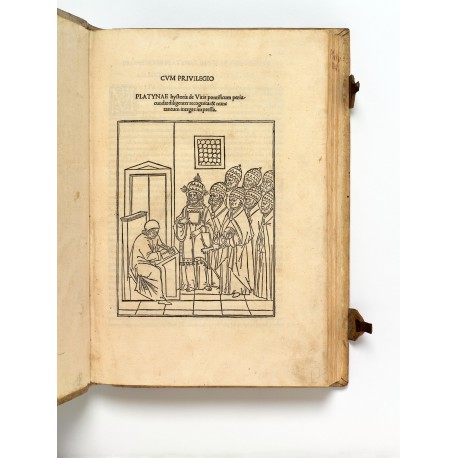 View larger
View larger
Hystoria de vitis pontificum periucunda: diligenter recognita: & nunc tantum integre impressa
- Subjects
- Popes - Biography - Early works to 1800
- Women in literature - Early works to 1800
- Authors/Creators
- Platina (Sacchi), Bartolomeo, 1421-1481
- Printers/Publishers
- Pincio (Pinzi), Filippo, active 1490-1530
- Owners
- Fürstlich Fürstenbergische Hofbibliothek (Donaueschingen)
- Other names
- Guazzelli, Pietro Demetrio, died 1511
- Sixtus IV, Pope, 1414-1484
Platina (Sacchi), Bartolomeo
Piadena (Cremona) 1421 – 1481 Rome
Hystoria de vitis pontificum periucunda: diligenter recognita: & nunc tantum integre impressa
Venice, Filippo Pincio, 1504 (22 August)
Two parts, folio (315 × 215 mm), (146, 53) ff. signed a-r8 s10, A–F8 G6 (– blank G6, cancelled) and foliated 1–46 (54). Woodcut on title-page (borderline 172 × 140 mm), numerous initials from several alphabets.
provenance Fürstlich-Fürstenbergische Bibliothek at Donaueschingen, although without its usual ink stamp — sale by Reiss & Sohn, ‘Auktion 70: Aus einer Süddeutschen Fürstenbibliothek, Teil 2’, Königstein im Taunus, 4 May 2000, lot 1642
In immaculate state of preservation.
binding contemporary South German alum-tawed pigskin over wooden boards, covers decorated in blind by three rolls and two stamps (see below); two clasps and two catches (one catch working).
A new edition of the Vitae pontificum, Platina’s famous chronicle of the papacy through its 1500-year history (previously printed 1479, 1481, 1485), here united with his Contra amores (Against Love Affairs), a ‘misogynistic critique of women which had significant influence on later writers’1 (previously printed 1481), five unpublished minor works, and ‘Parentalia B. Platynae’, a collection by the author’s friend Pietro Demetrio Guazzelli of verse eulogies recited on 18 April 1482, at a memorial banquet in Platina’s former home, also unpublished.2
The author writing his book in front of eight Popes. No subsequent use of the woodcut is known.
Height of binding 330 mm
The five works by Platina printed here for the first time are ‘Dialogus de falso & vero bono’, a treatise on moral philosophy in three books, written 1468–1469 while he was imprisoned in Castel Sant’Angelo on charges including sodomy, paganism, conspiracy, and heresy, subsequently dedicated to Sixtus iv; ‘De vera nobilitate’, written shortly after Platina’s appointment (1475) as Vatican librarian, and dedicated to Giovanni Orsini; ‘De optimo cive’, arguing that contemplative life is inferior to active life (in as much as the latter is more useful for the common good), written 1474, and dedicated to Lorenzo de’ Medici; ‘Panegyricus Bessarioni’, a tribute to Cardinal Bessarion, presented as a gift in early 1471; and ‘De pace Italiae confirmanda & bello Thurcis indicendo’, written 1468, and addressed to Pius ii.
The large woodcut on the title-page depicts Platina writing at a table in front of eight Popes, including St. Peter and Pope Sixtus iv, to whom Platina had presented his book in 1475. ‘Cette gravure mérite d’être classée parmi les plus intéressantes… Elle se ressent de l’école du Poliphile’.3 The woodcut was prepared for this edition and no subsequent use of it is known (different woodcuts decorate Filippo Pincio’s reprint of 1511 and Guglielmo da Fontaneto’s edition of 1518; see Essling nos. 1430–1431).
The tools used to decorate the binding are associated with the ‘Heidelberg Blumentopf’ workshop. According to present knowledge, this shop was active from 1476 until 1528, and employed eighteen rolls and fifty-eight stamps. The largest of the three rolls decorating this binding measures 115 × 20 mm and depicts in half-figure a Triton and a Nereid amidst foliage; the other two rolls measure 168 × 15 mm and 125 × 15 mm, and depict respectively birds amidst foliage, and flowers and foliage.4 Two stamps are employed: one is a flower blossom5 and the other a rosette.6
references Victor Masséna, prince d’Essling, Les livres a figures vénitiens… Seconde partie (Florence & Paris 1909), i, pp.87–88, no. 1429 (reproducing title-page); Herbert M. Adams, Catalogue of books printed on the Continent of Europe, 1501–1600, in Cambridge libraries (Cambridge 1967), P–1412; Max Sander, Le livre à figures italien, depuis 1467 jusqu’à 1530 (reprint Nendeln 1969), no. 5743 and pl. 284
1. Mary Ella Milham, ‘The Neglected Works of Platina’ in Acta Conventus Neo-Latini Abulensis, edited by Rhoda Schnur (Tempe 2000), p.461; Stefan Bauer, The Censorship and Fortuna of Platina’s Lives of the Popes in the Sixteenth Century (Turnhout 2006), pp.46–49, 232.
2. The text is printed from the same manuscript (Florence, Biblioteca Nazionale, Conv. Soppr. C-iv-797) used for the edition printed by Johannes de Colonia and Johannes Manthen at Venice in 1479. Written in the late 1460s, probably by Guazzelli, and annotated by Platina and by the humanist Pomponio Leto, the manuscript is heavily marked-up by the compositors of both the 1479 and 1504 editions; see Piero Scapecchi, ‘Un nuovo codice del “Liber de vita Christi ac omnium pontificum” di Bartolomeo Platina usato come esemplare di tipografia per le edizioni veneziane del 1479 e del 1504’ in RR Roma nel Rinascimento (1999), pp.247–252.
3. Victor Masséna prince d’Essling, Bibliographie des livres à figures vénitiens de la fin du xvie siècle et du commencement du xvie, 1469–1524 (Paris 1892), p.245.
4. Konrad Haebler, Rollen- und Plattenstempel des xvi. Jahrhunderts (Leipzig 1929), ii, p.250 nos. 4–5; Ernst Kyriss, Verzierte gotische einbände im alten deutschen Sprachgebiet (Stuttgart 1958), iii, pp.88–89 no. 147, Tafel 295 nos. 2–4; Einbanddatenbank (ebdb), Werkstatt w000110: r000449–r000451 (www.hist-einband.de).
5. Kyriss, op. cit., no. 147, Tafel 295 no. 1 (also no. 142, Tafel 290 no. 1); Einbanddatenbank (EBDB), s009192.
6. Einbanddatenbank (EBDB), s009168.



